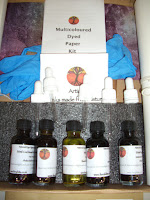19th June 2025
Helen's journey started with spinning, she was then taught felting by Sheila Smith making a scarf and then waistcoats, throughout this process she kept records and learned much from the making process.
She also uses the wool to crochet, making for example a 'fantastic coat'.
She then went to a natural dye workshop (initially Helen used synthetically dyed textiles) and following this has created her own natural dyes which she uses to dye merino wool for her work. She uses concentrated extract of natural dyes to paint onto fabric/wool/fibres.
An exhibition of textiles/felt from Central Asia - Kyrgyzstan, influenced her ideas for colours, patterns and designs. All the dyes used were natural and this led Helen to use indigo.
Helen has produced 4 books related to natural dyes including colours of sea and sky (indigo) and colours of the rainbow.
Initially she made her own paper to stitch, batik, paint over with inks and then rip up in order to stitch by hand or machine onto her pictures as featured on the stones i the river in spate picture.
In other work Helen uses fine Japanese paper, stitched and painted together with ideas from the countryside which she develops to create pictures eg Slate fences, stone walls, path to the stile and standing stones (machine and hand stitched into with doodles).
 Helen uses 'solar dying' using solar pots - she uses Kilner jars to put dye in with one colour at the bottom and another at the top (multi colour), then puts wool or silk fabric into them and leaves them in the sun, this creates multicoloured fibres and
Helen uses 'solar dying' using solar pots - she uses Kilner jars to put dye in with one colour at the bottom and another at the top (multi colour), then puts wool or silk fabric into them and leaves them in the sun, this creates multicoloured fibres and fabrics to use.







No comments:
Post a Comment
Note: only a member of this blog may post a comment.